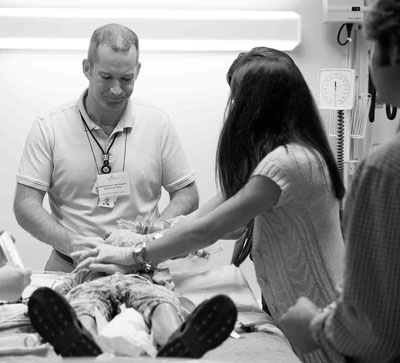Can we work better in teams?
The balding, grey-haired wig on the 20-something "patient" looks a little peculiar, but there's no hint of a smirk or giggle from the students—only looks of intense concentration and concern. Somehow, within moments of entering the simulation room, this case has become real.
The medical student assigned to the role of attending physician confidently goes over discharge instructions, delivering them just as she’s been taught, and then asks the patient if he has any questions. When he says no, she shakes his hand and exits the room, leaving the rest of the team to finish the discharge work. For a moment, she lingers in the hallway, seemingly unsure of what to do or where to go next. Then she walks out of view from the hidden cameras and disappears.
“Where is she going?” asks Elisabeth Carr, M.D., assistant professor (clinical) of medicine, incredulously, as she watches the whole thing unfold from the simulation control room. “Should I tell her to come back in?” asks one of the techs. “No, let her stay out there,” says Carr, shaking her head. “It’s all part of the learning process.”
For the next half-hour, the remaining team members (a medical resident, a nursing student and a pharmacy student) discuss medication, mobility and physical therapy issues related to discharge. And then the scenario gets complicated—by design. When the team discovers that the elderly patient lives by himself, has a history of falling and has no transportation to follow-up appointments, they realize they need a consult with a physical therapist and a social worker before discharging the patient. They also realize they need the attending physician to revise the discharge plan and order the additional services, but she—believing her job is done—is nowhere to be found.
“As a student, you’re typically taught only your specific role,” says Carolyn Scheese, M.S., R.N., assistant professor (clinical) and founding director of the Simulation Learning Center at the College of Nursing. Because they are trained separately in different buildings by different faculty in classes that focus almost exclusively on their profession’s specific roles, students develop a tunnel-vision focus.
When they bring that myopic perspective into the complex, real-world patient environment, however, it compromises safety, quality and patient satisfaction. “One of the leading causes of death is being admitted to a U.S. hospital, and failure to communicate with members of the treatment team is the most common cause for it,” says Karen Paisley, Ph.D., M.S., associate dean for academic affairs in the College of Health and one of the facilitators of team-based simulation courses.
While other industries like aerospace and high tech use highly synchronized mission control teams to coordinate even the smallest actions, health care providers often fail to communicate the most essential pieces of patient information, from current medications to lab results. Teaching practitioners to work collaboratively, instead of zeroing in on their individual objectives, is one of the greatest challenges and imperatives in medicine today. The barriers, however, can seem overwhelming.
What could be so difficult? The first obstacle is getting all the decision makers to agree that interprofessional education is a priority. Once that is accomplished, there are the schedules of hundreds of students from different schools that already have packed curricula. Then there’s the issue of who’s going to pay for it. Training, especially in simulation centers, is expensive, and allocating costs to different schools and departments can stir up a hornet’s nest of confusion. Finding faculty who practice interdisciplinary principles and who are willing to create complex scenarios and facilitate the group poses yet another vexing problem. And figuring out how these facilitators are compensated and rewarded for their work opens up larger questions about what we value and who we promote in our academic medical centers. The path of least resistance for many schools is to opt out and hope the best for their students and their patients.
“If we wait for all the right resources to line up or for some big grant to come through, it will never happen,” says Maureen Keefe, Ph.D., R.N., professor and former dean of the College of Nursing. “Instead, we have to use our pioneering, entrepreneurial spirit to make it happen.”
In the spring of 2012, Keefe, the deans of the colleges of Pharmacy and Health and the School of Medicine, and the director of the Spencer S. Eccles Health Sciences Library, decided to do just that. Four months later, in time for the beginning of the school year, they had integrated three required interprofessional education courses into the curriculum for medical, nursing, pharmacy, health and dentistry students. “It’s expensive. It’s time consuming. And it can seem virtually impossible to get everyone together in the same room,” says Scheese, who has watched hundreds of students participate in team trainings. “But at the end of the day, it’s worth it.” Students learn critical communication skills and begin to understand the important expertise that other disciplines bring to the table. They also learn to draw on each other’s strengths and work as a team during challenging situations.
While requiring students to take team-based classes is a step in the right direction, it admittedly seems like a drop in the proverbial bucket. The ability to work in teams is critical for every aspect of health care; it’s not just a course to take in school. But to get there, we’ll have to challenge our most deeply held notions about how we train and practice. And we have to take our students into uncharted territory where few, if any, of our faculty have been—true team-based interprofessional care.



